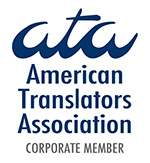Have you ever been asked to take a translation test?
When working with a new client, you will often be asked to complete a short translation test. The design of these tests may vary, but industry standard is currently to simply send a 200-500 word text for translation. This test is then assessed by a senior translator.
In other cases, you may be asked to demonstrate your ability with a certificate. This certificate demonstrates that you already took a recognized test, such as the ATA Certification Exam, or a test for a specific translation agency.
Sometimes, having a certificate will save you from having to take an agency’s test. But whichever test you need to take, this post will offer instructions on what to expect, as well as how to ace it with flying colors.
.
PAYMENT
Some translation companies will offer to pay you to take this test, and some will not.
This will often depend on how much experience you have to show them. Newer translators without established credentials should expect to do these tests unpaid.
Tests for certification procedures (such as the American Translator’s Association Certification) will require the testee to pay, as the test is for the testee’s own credentialing purposes.
.
FEEDBACK
Translation companies will, under very rare circumstances, allow you to see your evaluator’s feedback. However, many translation project managers are simply too busy to do so.
It is unfortunate, because otherwise this would be a great learning opportunity! But if you never hear back after your translation test, don’t give up, and don’t take it personally.
The ATA does not provide feedback.
.
THE TRANSLATION TEST ITSELF
Here are some tips on what you can do (besides being a great translator) to ensure a high score on your translation test.
1) Carefully read all instructions.
Starting from the first e-mail you receive, to the instructions in the test itself. Ability to follow instructions is a crucial part of the test (and indeed, part of any translation).
Part of those instructions is meeting the deadline: your clients, whether they be direct clients or LSP’s, are often trying to manage several moving parts at once. If a translation doesn’t arrive in time it can cause untold problems. Deadlines matter. Missing a deadline on a translation test usually means you will not be contacted again.
.
2) Only take the test if you are translating INTO your native language.
Translators must be excellent writers of the target language. They must also be intimately aware of the various styles and trends in that language, whether the text is for a newspaper, fashion magazine, academic paper voice, marketing material, or internal company memo.
Very few translators can effectively translate in both directions. Take a hard look at your own educational experiences and skills, and ask yourself which language demonstrates your best writing.
.
3) Do not translate too literally
By literally we don’t just mean word-for-word. Sometimes a translation that is grammatically correct and semantically accurate is still simply something that would never be said in your target language.
For example, French letters often sign off with the lengthy “Veuillez recevoir, Monsieur/Madame, nos salutations distinguées.”
However, English letters make do with a pithy “Best regards”. Translating the French literally would result in a text that looks quite awkward for the English reader.
In the same vein, don’t feel like you need to keep those long Spanish sentences the same length in English, or mirror English syntax in Korean.
Instead, pay special care to transitions, sentence length, flow, and redundancies. While you should ensure you include all information written in the source, your sentences do not need to match the source one to one in terms of structure. Your finished product should be a text your university writing professor wouldn’t tear apart.
..
4) Do your research.
Check every name (public figures, buildings, organizations) and make sure that similar texts in the target language use the same phrasing you do.
Google (or Baidu, Yandex, or Naver) is your friend.
Linguee.com is a helpful resource but should be used WITH CAUTION – there are a lot of bad translations that feed into its corpus.
.
Are you looking for ways to continue to grow as a linguist or translator?
We offer continuing education options through our online courses.
5) Read your translation over SEVERAL TIMES before submitting.
You’ll be surprised what you catch. Beyond errors and typos, you might realize that the change you made to one sentence makes the transition to the next a bit awkward. You’ll want to fix that before submitting to the client.
.
6) Put any notes you might have as inserted comments.
Do NOT put notes in the text in parentheses or highlighted text, as this is confusing to editors. This includes notes on why you chose a certain term if you feel it might be disputed or discarded too easily by an evaluator (ideally, include links to your research) or requests for clarification on a point that you feel has an ambiguous interpretation. Do not guess! Clients are always happy to see that a translator is striving towards creating an accurate translation, even when they might not have all the information necessary at that moment to do so.
We hope this helps you ace your translation test! Have other suggestions or questions? Leave them in the comments!
Interested in working as a translator or translation proofreader?
Download our tests, and have results within 48 hours.




Great article. I quite agree with you about only translating into your native language. I’m often amazed at the low standard of some translations which have been carried out by non-native translators. Those who want a quick cheap translation may not realise this, but companies who ask for a translation test certainly will!
It’s so important to have a natural sounding article. I translate articles from Spanish to English and if these were done literally they would actually sound as if they were written by a child sometimes! That doesn’t mean the original Spanish was “childish” in any way; it sounds fine and natural in Spanish, but considerable changes have to be made to the English to make it natural sounding. Often you will have to completely rewrite the sentences, and companies will certainly appreciate your efforts, especially if you point this out to them in separate notes for example.
I am a senior translator, and I get this request a lot, probably because I often work on short-term projects with new clients.
The funny thing is – most of the reviewers that are hired to review my work are not competent translators. So I usually have to explain why ‘a deed of trust’ cannot be translated literally and why “there are ‘missing’ words” and other basic things.
All of them (the reviewers) have 15+ years of experience as well, so it is hard for our end clients or agencies to separate the wheat from the chaff. It would be so much easier to have a professional credential, so I look forward to completing this test. I like all the tips and I’d add mine – eat dark chocolate! It makes your brain translate in wondrous ways.
I understand sometimes clients need to check our translating abilities, but those excerpts they send, with hardly any context, can be very hard to properly translate. I remember doing a test for a client who was looking for a translator for her romance-sci fi novel, and she sent a small part (around 700-800 words) in which one of the characters, who was from another planet, said “you′re my mine”. I knew this alien spoke a different language so, did he mean to say “you′re mine” and it was a typo or is calling someone “my mine” a cute nickname people from his planet use? I translated it as if it were a typo, but wrote a comment about it. I never found out the truth because someone else was hired to do it, but it surely gave me a headache!